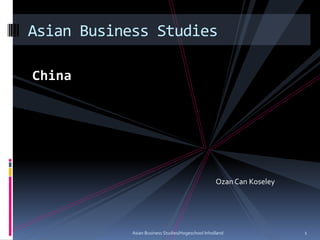
China's state enterprises
- 1. China Asian Business Studies/Hogeschool Inholland 1 Asian Business Studies Ozan Can Koseley
- 2. China Reforming managerial mechanisms of Chinese state enterprises Asian Business Studies/Hogeschool Inholland 2
- 3. Structural and managerial problems of the CSEs Asian Business Studies/Hogeschool Inholland 3
- 4. Managerial Development in CSEs4 STAGES Nationalization – Soviet model 1949 - One director management system - Made contribution to the heavy industry - A poor fit with Chinese communist aspirations - China had very few technically trained managers Reforms 1956-1961 - Participation of party comittees and workers Cultural revulation 1965 - Managers are discredited, revulationary workers were given the power Current reforms 1980s Asian Business Studies/Hogeschool Inholland 4
- 5. The line-function system of management People in functional departments Directors ideollagacilly loyal to the party Independent system for each factory Asian Business Studies/Hogeschool Inholland 5
- 6. Problems within party structure Resbonsibilities of enterprise leaders An ideological control over enterprise Power distribution Inefficient structure Asian Business Studies/Hogeschool Inholland 6
- 7. Asian Business Studies/Hogeschool Inholland 7
- 8. 2 additional systems to manage Life-support system - Support workers off-work activites Sociapolitical support system - ACTFU -ACWF - Communist youth league - Militia Asian Business Studies/Hogeschool Inholland 8
- 9. Personnel management Iron ruling chairs No rights to hire or fire Iron rice bowl Political in doctrination Asian Business Studies/Hogeschool Inholland 9
- 10. Financial Management State financial control Restricted funds Delivering income Focus on product quantity and value Lack of using funds Asian Business Studies/Hogeschool Inholland 10
- 11. Major reform measures and existing problems of the CSEs Asian Business Studies/Hogeschool Inholland 11
- 12. Reforms after 1979 The experimentalapproach 1984 China’s Economic Structure Reform Industry responsibility system Profit and loss contract Enterprise director leads Reduced influence of the party Increased financial responsibility Western management techniques Asian Business Studies/Hogeschool Inholland 12
- 13. But there still remains a series of major problems The supply and demand balance has shifted to bigger supply More competition Many CSEs still operate at a loss and depend upon state subsidies The “Triangular debt” cycle Asian Business Studies/Hogeschool Inholland 13
- 14. Why these major problems? CSEs had not yet obtained true autonomy Many related policies in finance, pricing, and taxation lagged behind Many CSEs had not established good sales mechanisms Most of the CSEs still held on the old straight-line functional model The CSEs still had to carry heavy social burdens by maintaining their life support systems The “three irons” problems had remained very serious Asian Business Studies/Hogeschool Inholland 14
- 15. Govermental measures of reforming the CSEs and their likely impacts 15 Asian Business Studies/Hogeschool Inholland
- 16. The regulations for transforming Managerial Mechanism of the State Owned Enterprises Production management power Power to price service and products Power to sell their products Import and export power Power to make investment desicions Power to dispose of their properties Power to merge 16 Asian Business Studies/Hogeschool Inholland
- 17. The regulations for transforming Managerial Mechanism of the State Owned Enterprises Power to determine workforce Personal managementpower Power to setup various sub-organizations Power to wage Power to refuse govermental apportionment 17 Asian Business Studies/Hogeschool Inholland
- 18. Power to manage production Scope of production and business Power to demand contracts Readjustment of supply 18 Asian Business Studies/Hogeschool Inholland
- 19. Power to make investment desicions Use reserve capital to invest on productive projects International investment Developing enterprises overseas 19 Asian Business Studies/Hogeschool Inholland
- 20. Power to price products and services CSEs freely set prices 20 Asian Business Studies/Hogeschool Inholland
- 21. Power to import and export Choosing any foreign trade institution Power to participate in negotiations Determine their own currency 21 Asian Business Studies/Hogeschool Inholland
- 22. Power to manage human resorces Deciding aspects for hiring employees Hiring from abroad Power to allocate wages and bonuses 22 Asian Business Studies/Hogeschool Inholland
- 23. Regulations to intensify responsibilities Link between total income and economic benefits Responsibility of the directors Responsibility of the CSEs Corporate taxes leveled for all players 23 Asian Business Studies/Hogeschool Inholland
- 24. The role of government in four main areas Establishing a macro-control management Promoting the role of market system Social security system Developing public facilities and welfare institutions 24 Asian Business Studies/Hogeschool Inholland
- 25. Still problems to solve Failing management Uncertain ownership Enterprise leadership SOEs lag behind Competition 25 Asian Business Studies/Hogeschool Inholland
- 26. The guide for CSEs The ownership issue A shareholding system Joint-stock companies Cooperation with foreign partners Relationship CEO and Party Focusing comparative advantage Tackle corruption Strategic alliances with other enterprises 26 Asian Business Studies/Hogeschool Inholland
- 27. Comparative Chinese managerial system Asian Business Studies/Hogeschool Inholland 27
- 28. Organisational structure Asian Business Studies/Hogeschool Inholland 28
- 29. CFBs and CSEs organisational structure 29 Asian Business Studies/Hogeschool Inholland
- 30. Management process 30 Asian Business Studies/Hogeschool Inholland
- 31. Comparison of CFBs and CSEs The management process The control process Guanxi and Xinyong 31 Asian Business Studies/Hogeschool Inholland
- 32. Management process Didactic style of leadership Power distance 32 Asian Business Studies/Hogeschool Inholland
- 33. Process control Lack of measuring employee performance Loyalty is important 33 Asian Business Studies/Hogeschool Inholland
- 34. Guanxi and Xinyong External relationships Business ties 34 Asian Business Studies/Hogeschool Inholland
- 35. Competitive Strategies and tactics 35 Asian Business Studies/Hogeschool Inholland
- 36. Competitive strategies and tactics of the overseas Chinese in Southeast Asia Low margin/high turnover Economy of scope Political sensitivity and high degree of sophistication in forming alliances of convenience Flexibility 36 Asian Business Studies/Hogeschool Inholland
- 37. CSEs in mainland China They have not been able to develop competitive business strategies until only recently Why? The CSEs were dominated and overprotected by the state in terms of industrial material input, market share, and financial support They still have to develop their competitive strategies to be able to expand or even maintain their traditional market shares. 37 Asian Business Studies/HogeschoolInholland
